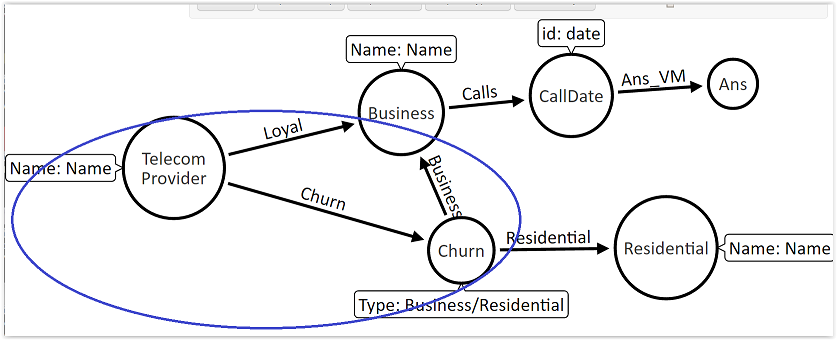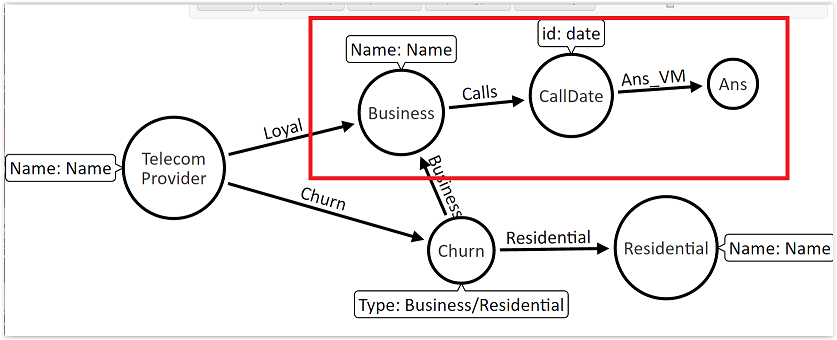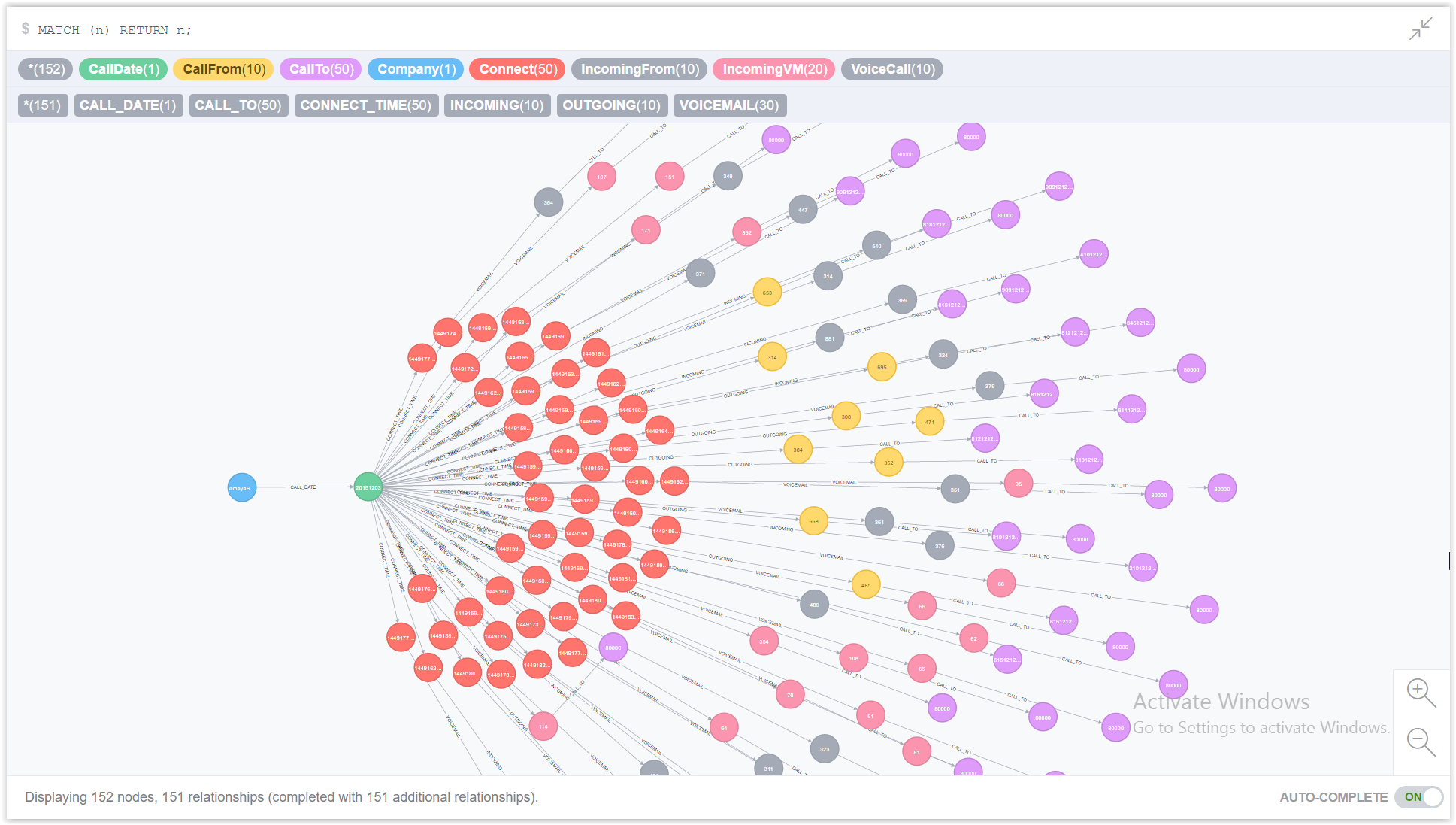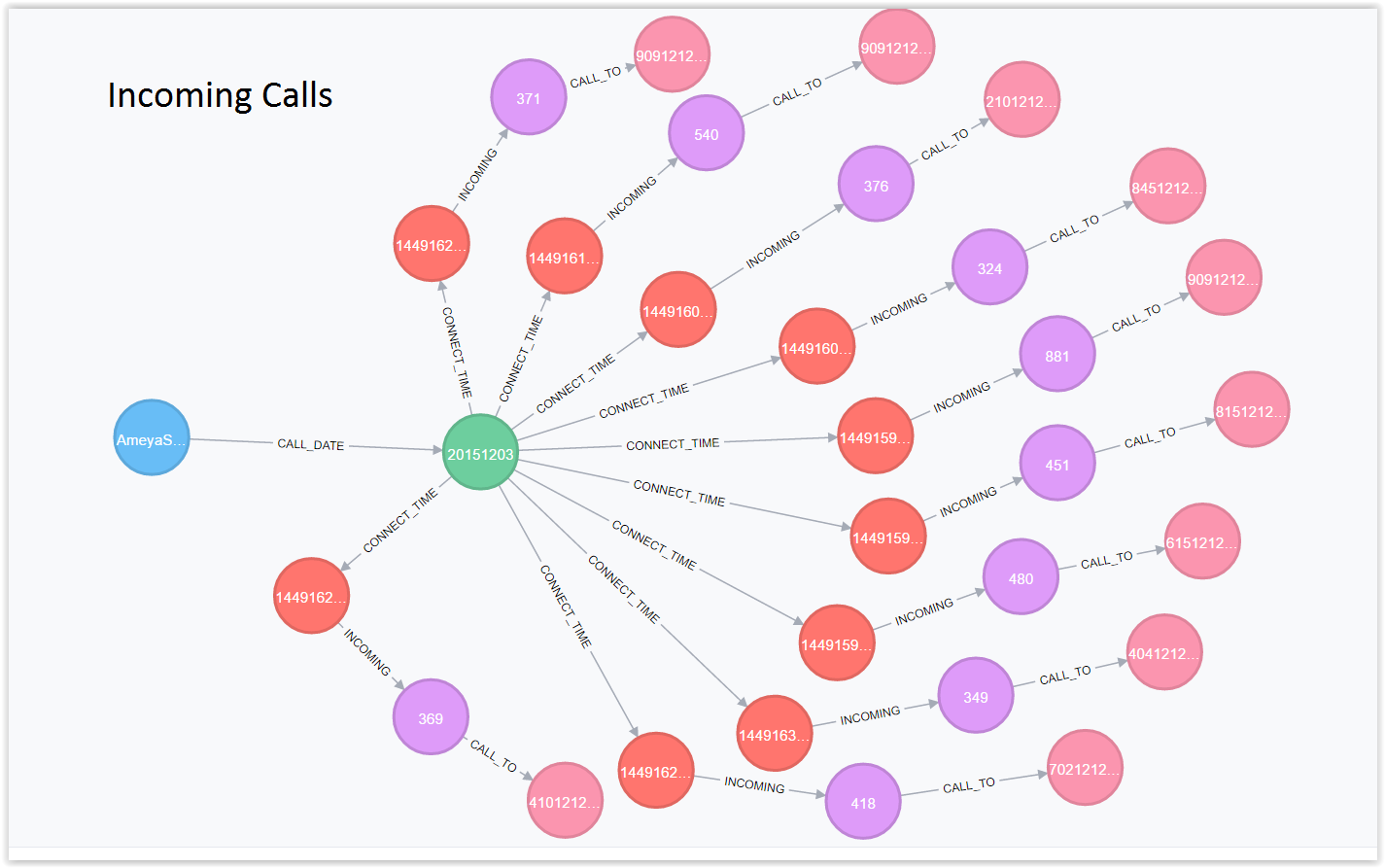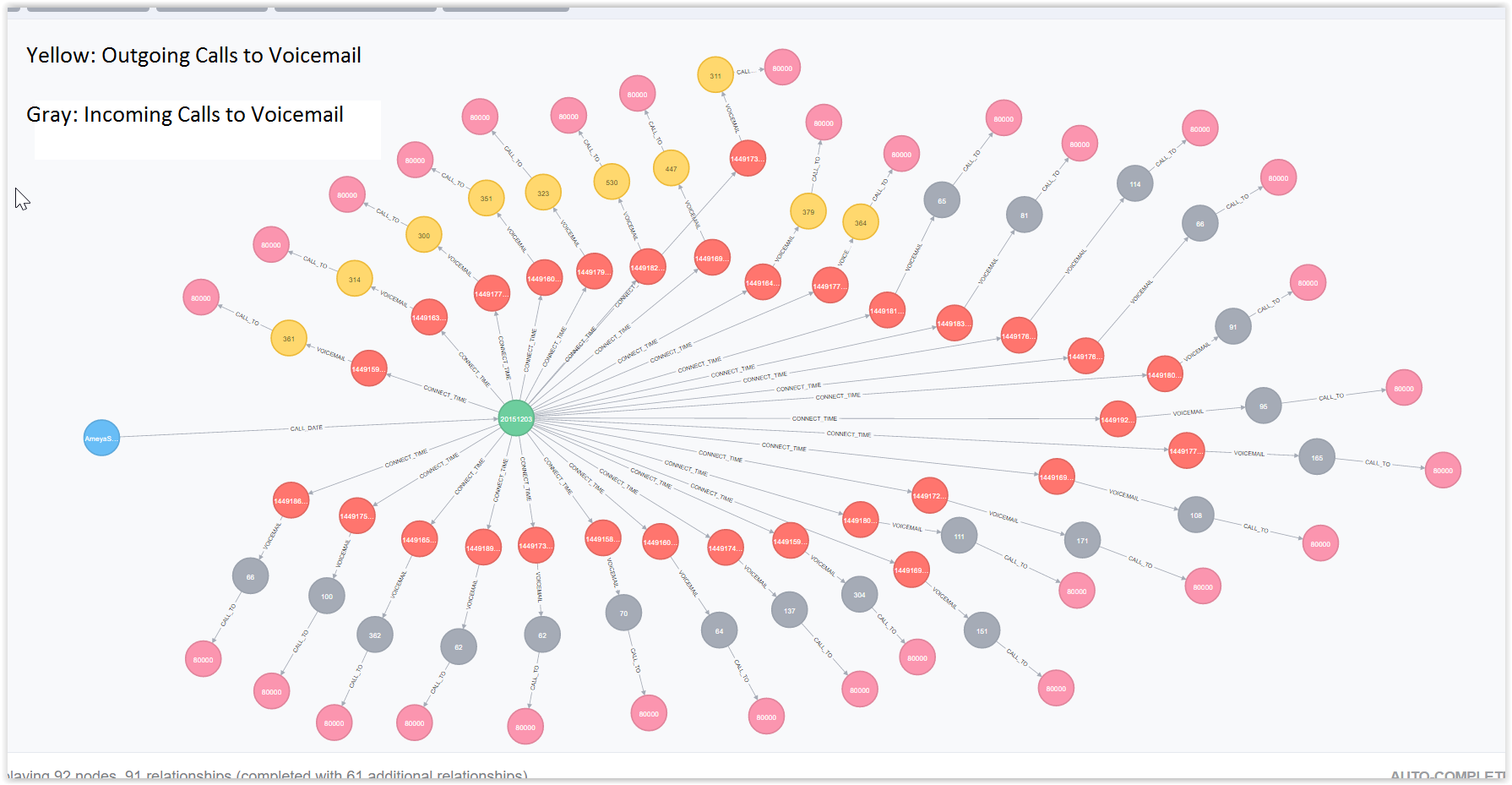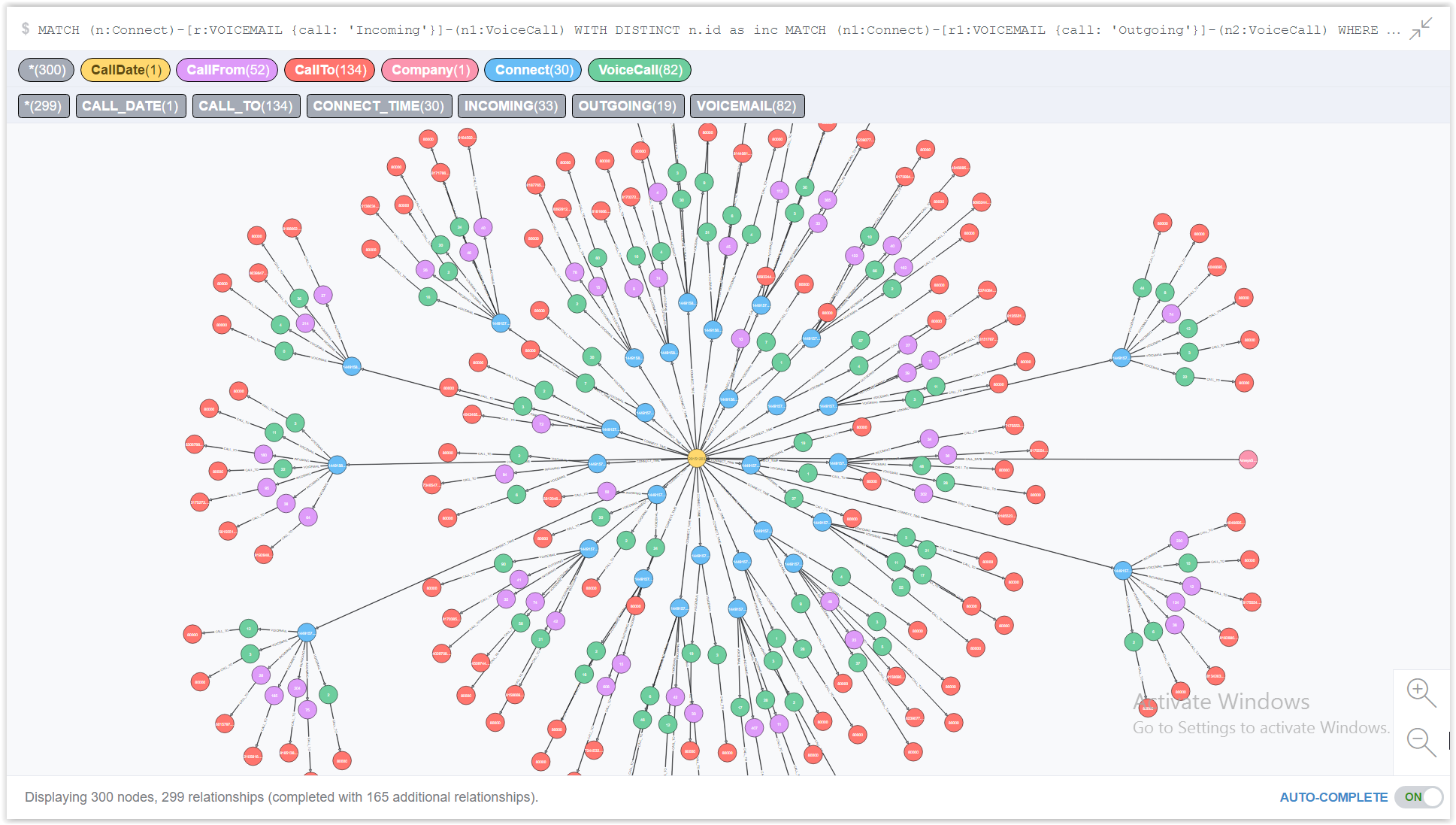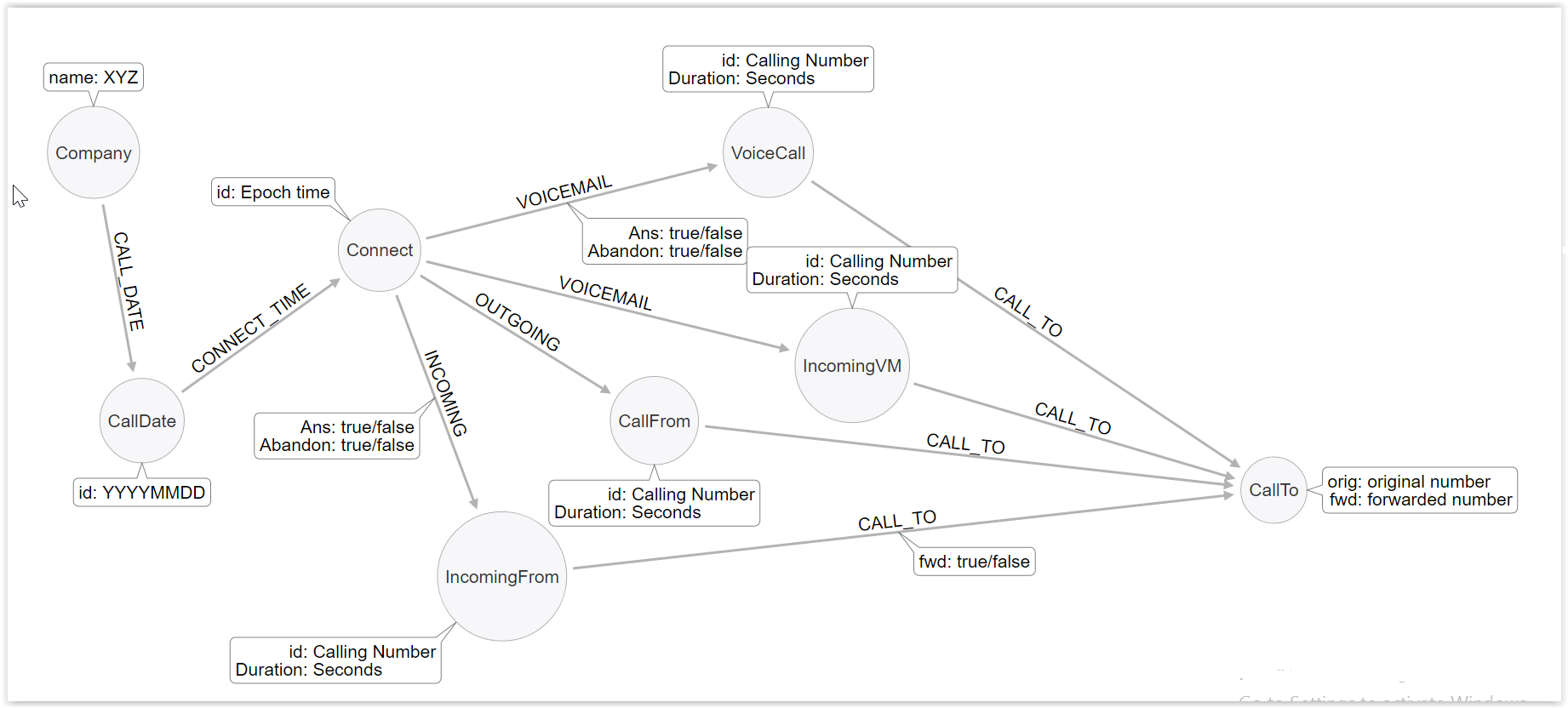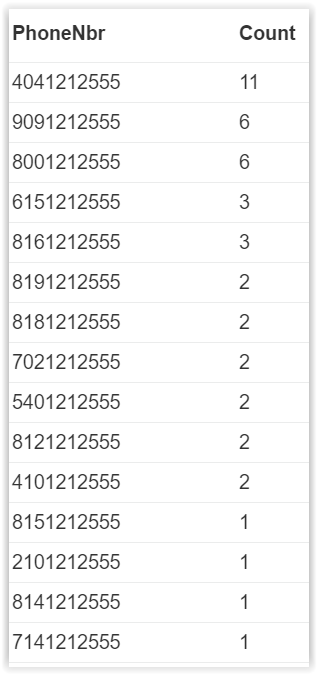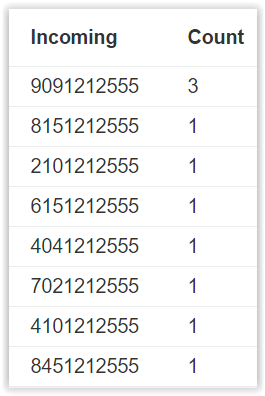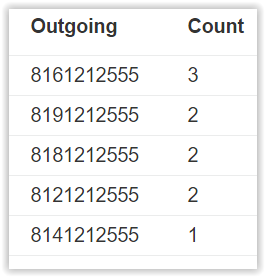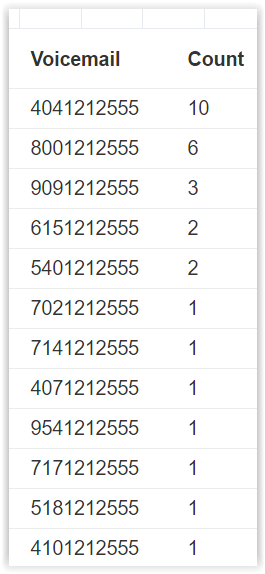CREATE (company:Company {name: "AmeyaSoft"})
CREATE (calldate:CallDate {id: 20151203})
CREATE (company)-[:CALL_DATE]->(calldate)
CREATE (connect:Connect {id: 1449158574})
CREATE (calldate)-[:CONNECT_TIME {date: 20151203}]->(connect)
CREATE (called:CallTo {orig: "4041212555", fwd: "80000"})
CREATE (callingvm:IncomingVM {id: "4045551212", duration: 70})
CREATE (connect)-[:VOICEMAIL {call: "Incoming", Abandon: false}]->(callingvm)
CREATE (callingvm)-[:CALL_TO]->(called)
CREATE (connect1:Connect {id: 1449159132})
CREATE (calldate)-[:CONNECT_TIME {date: 20151203}]->(connect1)
CREATE (called1:CallTo {orig: "8191212555", fwd: "8191212555"})
CREATE (calling1:CallFrom {id: "9195551212", duration: 458})
CREATE (connect1)-[:OUTGOING {ans: true, Abandon: false}]->(calling1)
CREATE (calling1)-[:CALL_TO {fwd: false}]->(called1)
CREATE (connect2:Connect {id: 1449159135})
CREATE (calldate)-[:CONNECT_TIME {date: 20151203}]->(connect2)
CREATE (called2:CallTo {orig: "5401212555", fwd: "80000"})
CREATE (callingvm2:IncomingVM {id: "8045551212", duration: 304})
CREATE (connect2)-[:VOICEMAIL {call: "Incoming", Abandon: false}]->(callingvm2)
CREATE (callingvm2)-[:CALL_TO]->(called2)
CREATE (connect3:Connect {id: 1449159146})
CREATE (calldate)-[:CONNECT_TIME {date: 20151203}]->(connect3)
CREATE (called3:CallTo {orig: "8151212555", fwd: "8151212555"})
CREATE (calling3:IncomingFrom {id: "2705551212", duration: 451})
CREATE (connect3)-[:INCOMING {ans: true, Abandon: false}]->(calling3)
CREATE (calling3)-[:CALL_TO {fwd: true}]->(called3)
CREATE (connect4:Connect {id: 1449159149})
CREATE (calldate)-[:CONNECT_TIME {date: 20151203}]->(connect4)
CREATE (called4:CallTo {orig: "8121212555", fwd: "8121212555"})
CREATE (calling4:CallFrom {id: "9735551212", duration: 384})
CREATE (connect4)-[:OUTGOING {ans: true, Abandon: false}]->(calling4)
CREATE (calling4)-[:CALL_TO {fwd: false}]->(called4)
CREATE (connect5:Connect {id: 1449159162})
CREATE (calldate)-[:CONNECT_TIME {date: 20151203}]->(connect5)
CREATE (called5:CallTo {orig: "8121212555", fwd: "8121212555"})
CREATE (calling5:CallFrom {id: "2145551212", duration: 695})
CREATE (connect5)-[:OUTGOING {ans: true, Abandon: false}]->(calling5)
CREATE (calling5)-[:CALL_TO {fwd: false}]->(called5)
CREATE (connect6:Connect {id: 1449159198})
CREATE (calldate)-[:CONNECT_TIME {date: 20151203}]->(connect6)
CREATE (called6:CallTo {orig: "6151212555", fwd: "6151212555"})
CREATE (calling6:IncomingFrom {id: "3525551212", duration: 480})
CREATE (connect6)-[:INCOMING {ans: true, Abandon: false}]->(calling6)
CREATE (calling6)-[:CALL_TO {fwd: true}]->(called6)
CREATE (connect7:Connect {id: 1449159229})
CREATE (calldate)-[:CONNECT_TIME {date: 20151203}]->(connect7)
CREATE (called7:CallTo {orig: "8191212555", fwd: "8191212555"})
CREATE (calling7:CallFrom {id: "5615551212", duration: 668})
CREATE (connect7)-[:OUTGOING {ans: true, Abandon: false}]->(calling7)
CREATE (calling7)-[:CALL_TO {fwd: false}]->(called7)
CREATE (connect8:Connect {id: 1449159334})
CREATE (calldate)-[:CONNECT_TIME {date: 20151203}]->(connect8)
CREATE (called8:CallTo {orig: "5181212555", fwd: "80000"})
CREATE (callingvm8:VoiceCall {id: "5185551212", duration: 361})
CREATE (connect8)-[:VOICEMAIL {call: "Outgoing"}]->(callingvm8)
CREATE (callingvm8)-[:CALL_TO]->(called8)
CREATE (connect9:Connect {id: 1449159420})
CREATE (calldate)-[:CONNECT_TIME {date: 20151203}]->(connect9)
CREATE (called9:CallTo {orig: "9091212555", fwd: "9091212555"})
CREATE (calling9:IncomingFrom {id: "8175551212", duration: 881})
CREATE (connect9)-[:INCOMING {ans: true, Abandon: false}]->(calling9)
CREATE (calling9)-[:CALL_TO {fwd: true}]->(called9)
CREATE (connect10:Connect {id: 1449159488})
CREATE (calldate)-[:CONNECT_TIME {date: 20151203}]->(connect10)
CREATE (called10:CallTo {orig: "8161212555", fwd: "8161212555"})
CREATE (calling10:CallFrom {id: "5615551212", duration: 314})
CREATE (connect10)-[:OUTGOING {ans: true, Abandon: false}]->(calling10)
CREATE (calling10)-[:CALL_TO {fwd: false}]->(called10)
CREATE (connect11:Connect {id: 1449159492})
CREATE (calldate)-[:CONNECT_TIME {date: 20151203}]->(connect11)
CREATE (called11:CallTo {orig: "8181212555", fwd: "8181212555"})
CREATE (calling11:CallFrom {id: "8155551212", duration: 352})
CREATE (connect11)-[:OUTGOING {ans: true, Abandon: false}]->(calling11)
CREATE (calling11)-[:CALL_TO {fwd: false}]->(called11)
CREATE (connect12:Connect {id: 1449159570})
CREATE (calldate)-[:CONNECT_TIME {date: 20151203}]->(connect12)
CREATE (called12:CallTo {orig: "8181212555", fwd: "8181212555"})
CREATE (calling12:CallFrom {id: "7135551212", duration: 653})
CREATE (connect12)-[:OUTGOING {ans: true, Abandon: false}]->(calling12)
CREATE (calling12)-[:CALL_TO {fwd: false}]->(called12)
CREATE (connect13:Connect {id: 1449159623})
CREATE (calldate)-[:CONNECT_TIME {date: 20151203}]->(connect13)
CREATE (called13:CallTo {orig: "8161212555", fwd: "8161212555"})
CREATE (calling13:CallFrom {id: "6155551212", duration: 485})
CREATE (connect13)-[:OUTGOING {ans: true, Abandon: false}]->(calling13)
CREATE (calling13)-[:CALL_TO {fwd: false}]->(called13)
CREATE (connect14:Connect {id: 1449160268})
CREATE (calldate)-[:CONNECT_TIME {date: 20151203}]->(connect14)
CREATE (called14:CallTo {orig: "7171212555", fwd: "80000"})
CREATE (callingvm14:VoiceCall {id: "7175551212", duration: 351})
CREATE (connect14)-[:VOICEMAIL {call: "Outgoing"}]->(callingvm14)
CREATE (callingvm14)-[:CALL_TO]->(called14)
CREATE (connect15:Connect {id: 1449160627})
CREATE (calldate)-[:CONNECT_TIME {date: 20151203}]->(connect15)
CREATE (called15:CallTo {orig: "8141212555", fwd: "8141212555"})
CREATE (calling15:CallFrom {id: "4075551212", duration: 471})
CREATE (connect15)-[:OUTGOING {ans: true, Abandon: false}]->(calling15)
CREATE (calling15)-[:CALL_TO {fwd: false}]->(called15)
CREATE (connect16:Connect {id: 1449160671})
CREATE (calldate)-[:CONNECT_TIME {date: 20151203}]->(connect16)
CREATE (called16:CallTo {orig: "8161212555", fwd: "8161212555"})
CREATE (calling16:CallFrom {id: "2145551212", duration: 308})
CREATE (connect16)-[:OUTGOING {ans: true, Abandon: false}]->(calling16)
CREATE (calling16)-[:CALL_TO {fwd: false}]->(called16)
CREATE (connect17:Connect {id: 1449160860})
CREATE (calldate)-[:CONNECT_TIME {date: 20151203}]->(connect17)
CREATE (called17:CallTo {orig: "8451212555", fwd: "8451212555"})
CREATE (calling17:IncomingFrom {id: "8455551212", duration: 324})
CREATE (connect17)-[:INCOMING {ans: true, Abandon: false}]->(calling17)
CREATE (calling17)-[:CALL_TO {fwd: true}]->(called17)
CREATE (connect18:Connect {id: 1449160936})
CREATE (calldate)-[:CONNECT_TIME {date: 20151203}]->(connect18)
CREATE (called18:CallTo {orig: "4041212555", fwd: "80000"})
CREATE (callingvm18:IncomingVM {id: "6781212555", duration: 64})
CREATE (connect18)-[:VOICEMAIL {call: "Incoming"}]->(callingvm18)
CREATE (callingvm18)-[:CALL_TO]->(called18)
CREATE (connect19:Connect {id: 1449160976})
CREATE (calldate)-[:CONNECT_TIME {date: 20151203}]->(connect19)
CREATE (called19:CallTo {orig: "2011212555", fwd: "2011212555"})
CREATE (calling19:IncomingFrom {id: "5125551212", duration: 376})
CREATE (connect19)-[:INCOMING {ans: true, Abandon: false}]->(calling19)
CREATE (calling19)-[:CALL_TO {fwd: false}]->(called19)
CREATE (connect20:Connect {id: 1449161939})
CREATE (calldate)-[:CONNECT_TIME {date: 20151203}]->(connect20)
CREATE (called20:CallTo {orig: "9091212555", fwd: "9091212555"})
CREATE (calling20:IncomingFrom {id: "9515551212", duration: 540})
CREATE (connect20)-[:INCOMING {ans: true, Abandon: false}]->(calling20)
CREATE (calling20)-[:CALL_TO {fwd: false}]->(called20)
CREATE (connect21:Connect {id: 1449162007})
CREATE (calldate)-[:CONNECT_TIME {date: 20151203}]->(connect21)
CREATE (called21:CallTo {orig: "9091212555", fwd: "9091212555"})
CREATE (calling21:IncomingFrom {id: "7145551212", duration: 371})
CREATE (connect21)-[:INCOMING {ans: true, Abandon: false}]->(calling21)
CREATE (calling21)-[:CALL_TO {fwd: true}]->(called21)
CREATE (connect22:Connect {id: 1449162054})
CREATE (calldate)-[:CONNECT_TIME {date: 20151203}]->(connect22)
CREATE (called22:CallTo {orig: "4101212555", fwd: "4101212555"})
CREATE (calling22:IncomingFrom {id: "2025551212", duration: 369})
CREATE (connect22)-[:INCOMING {ans: true, Abandon: false}]->(calling22)
CREATE (calling22)-[:CALL_TO {fwd: false}]->(called22)
CREATE (connect23:Connect {id: 1449162215})
CREATE (calldate)-[:CONNECT_TIME {date: 20151203}]->(connect23)
CREATE (called23:CallTo {orig: "7021212555", fwd: "7021212555"})
CREATE (calling23:IncomingFrom {id: "7855551212", duration: 418})
CREATE (connect23)-[:INCOMING {ans: true, Abandon: false}]->(calling23)
CREATE (calling23)-[:CALL_TO {fwd: false}]->(called23)
CREATE (connect24:Connect {id: 1449163024})
CREATE (calldate)-[:CONNECT_TIME {date: 20151203}]->(connect24)
CREATE (called24:CallTo {orig: "9541212555", fwd: "80000"})
CREATE (callingvm24:VoiceCall {id: "9545551212", duration: 314})
CREATE (connect24)-[:VOICEMAIL {call: "Outgoing"}]->(callingvm24)
CREATE (callingvm24)-[:CALL_TO]->(called24)
CREATE (connect241:Connect {id: 1449163781})
CREATE (calldate)-[:CONNECT_TIME {date: 20151203}]->(connect241)
CREATE (called241:CallTo {orig: "4041212555", fwd: "4041212555"})
CREATE (calling241:IncomingFrom {id: "4045551212", duration: 349})
CREATE (connect241)-[:INCOMING {ans: true, Abandon: false}]->(calling241)
CREATE (calling241)-[:CALL_TO {fwd: false}]->(called241)
CREATE (connect25:Connect {id: 1449164479})
CREATE (calldate)-[:CONNECT_TIME {date: 20151203}]->(connect25)
CREATE (called25:CallTo {orig: "8001212555", fwd: "80000"})
CREATE (callingvm25:VoiceCall {id: "9545551212", duration: 379})
CREATE (connect25)-[:VOICEMAIL {call: "Outgoing", Abandon: false}]->(callingvm25)
CREATE (callingvm25)-[:CALL_TO]->(called25)
CREATE (connect26:Connect {id: 1449165245})
CREATE (calldate)-[:CONNECT_TIME {date: 20151203}]->(connect26)
CREATE (called26:CallTo {orig: "9091212555", fwd: "80000"})
CREATE (callingvm26:IncomingVM {id: "9091212555", duration: 362})
CREATE (connect26)-[:VOICEMAIL {call: "Incoming", Abandon: false}]->(callingvm26)
CREATE (callingvm26)-[:CALL_TO]->(called26)
CREATE (connect27:Connect {id: 1449169344})
CREATE (calldate)-[:CONNECT_TIME {date: 20151203}]->(connect27)
CREATE (called27:CallTo {orig: "8001212555", fwd: "80000"})
CREATE (callingvm27:VoiceCall {id: "3035551212", duration: 447})
CREATE (connect27)-[:VOICEMAIL {call: "Outgoing", Abandon: false}]->(callingvm27)
CREATE (callingvm27)-[:CALL_TO]->(called27)
CREATE (connect28:Connect {id: 1449169392})
CREATE (calldate)-[:CONNECT_TIME {date: 20151203}]->(connect28)
CREATE (called28:CallTo {orig: "9091212555", fwd: "80000"})
CREATE (callingvm28:IncomingVM {id: "7021212555", duration: 151})
CREATE (connect28)-[:VOICEMAIL {call: "Incoming", Abandon: false}]->(callingvm28)
CREATE (callingvm28)-[:CALL_TO]->(called28)
CREATE (connect29:Connect {id: 1449169887})
CREATE (calldate)-[:CONNECT_TIME {date: 20151203}]->(connect29)
CREATE (called29:CallTo {orig: "9091212555", fwd: "80000"})
CREATE (callingvm29:IncomingVM {id: "5591212555", duration: 108})
CREATE (connect29)-[:VOICEMAIL {call: "Incoming", Abandon: false}]->(callingvm29)
CREATE (callingvm29)-[:CALL_TO]->(called29)
CREATE (connect30:Connect {id: 1449172878})
CREATE (calldate)-[:CONNECT_TIME {date: 20151203}]->(connect30)
CREATE (called30:CallTo {orig: "6151212555", fwd: "80000"})
CREATE (callingvm30:IncomingVM {id: "6151212555", duration: 171})
CREATE (connect30)-[:VOICEMAIL {call: "Incoming", Abandon: false}]->(callingvm30)
CREATE (callingvm30)-[:CALL_TO]->(called30)
CREATE (connect31:Connect {id: 1449173459})
CREATE (calldate)-[:CONNECT_TIME {date: 20151203}]->(connect31)
CREATE (called31:CallTo {orig: "4041212555", fwd: "80000"})
CREATE (callingvm31:IncomingVM {id: "6781212555", duration: 62})
CREATE (connect31)-[:VOICEMAIL {call: "Incoming", Abandon: false}]->(callingvm31)
CREATE (callingvm31)-[:CALL_TO]->(called31)
CREATE (connect32:Connect {id: 1449173679})
CREATE (calldate)-[:CONNECT_TIME {date: 20151203}]->(connect32)
CREATE (called32:CallTo {orig: "8001212555", fwd: "80000"})
CREATE (callingvm32:VoiceCall {id: "9735551212", duration: 311})
CREATE (connect32)-[:VOICEMAIL {call: "Outgoing", Abandon: false}]->(callingvm32)
CREATE (callingvm32)-[:CALL_TO]->(called32)
CREATE (connect33:Connect {id: 1449174539})
CREATE (calldate)-[:CONNECT_TIME {date: 20151203}]->(connect33)
CREATE (called33:CallTo {orig: "6151212555", fwd: "80000"})
CREATE (callingvm33:IncomingVM {id: "2701212555", duration: 137})
CREATE (connect33)-[:VOICEMAIL {call: "Incoming", Abandon: false}]->(callingvm33)
CREATE (callingvm33)-[:CALL_TO]->(called33)
CREATE (connect34:Connect {id: 1449175373})
CREATE (calldate)-[:CONNECT_TIME {date: 20151203}]->(connect34)
CREATE (called34:CallTo {orig: "5401212555", fwd: "80000"})
CREATE (callingvm34:IncomingVM {id: "5401212555", duration: 100})
CREATE (connect34)-[:VOICEMAIL {call: "Incoming", Abandon: false}]->(callingvm34)
CREATE (callingvm34)-[:CALL_TO]->(called34)
CREATE (connect35:Connect {id: 1449176076})
CREATE (calldate)-[:CONNECT_TIME {date: 20151203}]->(connect35)
CREATE (called35:CallTo {orig: "7021212555", fwd: "80000"})
CREATE (callingvm35:IncomingVM {id: "6021212555", duration: 114})
CREATE (connect35)-[:VOICEMAIL {call: "Incoming", Abandon: false}]->(callingvm35)
CREATE (callingvm35)-[:CALL_TO]->(called35)
CREATE (connect36:Connect {id: 1449176132})
CREATE (calldate)-[:CONNECT_TIME {date: 20151203}]->(connect36)
CREATE (called36:CallTo {orig: "4041212555", fwd: "80000"})
CREATE (callingvm36:IncomingVM {id: "4701212555", duration: 66})
CREATE (connect36)-[:VOICEMAIL {call: "Incoming", Abandon: false}]->(callingvm36)
CREATE (callingvm36)-[:CALL_TO]->(called36)
CREATE (connect37:Connect {id: 1449177292})
CREATE (calldate)-[:CONNECT_TIME {date: 20151203}]->(connect37)
CREATE (called37:CallTo {orig: "8001212555", fwd: "80000"})
CREATE (callingvm37:VoiceCall {id: "9515551212", duration: 300})
CREATE (connect37)-[:VOICEMAIL {call: "Outgoing", Abandon: false}]->(callingvm37)
CREATE (callingvm37)-[:CALL_TO]->(called37)
CREATE (connect371:Connect {id: 1449177501})
CREATE (calldate)-[:CONNECT_TIME {date: 20151203}]->(connect371)
CREATE (called371:CallTo {orig: "4071212555", fwd: "80000"})
CREATE (callingvm371:VoiceCall {id: "4075551212", duration: 364})
CREATE (connect371)-[:VOICEMAIL {call: "Outgoing", Abandon: false}]->(callingvm371)
CREATE (callingvm371)-[:CALL_TO]->(called371)
CREATE (connect38:Connect {id: 1449177594})
CREATE (calldate)-[:CONNECT_TIME {date: 20151203}]->(connect38)
CREATE (called38:CallTo {orig: "7141212555", fwd: "80000"})
CREATE (callingvm38:IncomingVM {id: "8011212555", duration: 165})
CREATE (connect38)-[:VOICEMAIL {call: "Incoming", Abandon: false}]->(callingvm38)
CREATE (callingvm38)-[:CALL_TO]->(called38)
CREATE (connect39:Connect {id: 1449179416})
CREATE (calldate)-[:CONNECT_TIME {date: 20151203}]->(connect39)
CREATE (called39:CallTo {orig: "8001212555", fwd: "80000"})
CREATE (callingvm39:VoiceCall {id: "8175551212", duration: 323})
CREATE (connect39)-[:VOICEMAIL {call: "Outgoing", Abandon: false}]->(callingvm39)
CREATE (callingvm39)-[:CALL_TO]->(called39)
CREATE (connect40:Connect {id: 1449180507})
CREATE (calldate)-[:CONNECT_TIME {date: 20151203}]->(connect40)
CREATE (called40:CallTo {orig: "4101212555", fwd: "80000"})
CREATE (callingvm40:IncomingVM {id: "2401212555", duration: 111})
CREATE (connect40)-[:VOICEMAIL {call: "Incoming", Abandon: false}]->(callingvm40)
CREATE (callingvm40)-[:CALL_TO]->(called40)
CREATE (connect41:Connect {id: 1449180703})
CREATE (calldate)-[:CONNECT_TIME {date: 20151203}]->(connect41)
CREATE (called41:CallTo {orig: "4041212555", fwd: "80000"})
CREATE (callingvm41:IncomingVM {id: "2141212555", duration: 91})
CREATE (connect41)-[:VOICEMAIL {call: "Incoming", Abandon: false}]->(callingvm41)
CREATE (callingvm41)-[:CALL_TO]->(called41)
CREATE (connect42:Connect {id: 1449181970})
CREATE (calldate)-[:CONNECT_TIME {date: 20151203}]->(connect42)
CREATE (called42:CallTo {orig: "4041212555", fwd: "80000"})
CREATE (callingvm42:IncomingVM {id: "4041212555", duration: 65})
CREATE (connect42)-[:VOICEMAIL {call: "Incoming", Abandon: false}]->(callingvm42)
CREATE (callingvm42)-[:CALL_TO]->(called42)
CREATE (connect43:Connect {id: 1449182480})
CREATE (calldate)-[:CONNECT_TIME {date: 20151203}]->(connect43)
CREATE (called43:CallTo {orig: "8001212555", fwd: "80000"})
CREATE (callingvm43:VoiceCall {id: "7605551212", duration: 530})
CREATE (connect43)-[:VOICEMAIL {call: "Outgoing", Abandon: false}]->(callingvm43)
CREATE (callingvm43)-[:CALL_TO]->(called43)
CREATE (connect44:Connect {id: 1449183491})
CREATE (calldate)-[:CONNECT_TIME {date: 20151203}]->(connect44)
CREATE (called44:CallTo {orig: "4041212555", fwd: "80000"})
CREATE (callingvm44:IncomingVM {id: "4041212555", duration: 81})
CREATE (connect44)-[:VOICEMAIL {call: "Incoming", Abandon: false}]->(callingvm44)
CREATE (callingvm44)-[:CALL_TO]->(called44)
CREATE (connect45:Connect {id: 1449186481})
CREATE (calldate)-[:CONNECT_TIME {date: 20151203}]->(connect45)
CREATE (called45:CallTo {orig: "4041212555", fwd: "80000"})
CREATE (callingvm45:IncomingVM {id: "7701212555", duration: 66})
CREATE (connect45)-[:VOICEMAIL {call: "Incoming", Abandon: false}]->(callingvm45)
CREATE (callingvm45)-[:CALL_TO]->(called45)
CREATE (connect46:Connect {id: 1449189294})
CREATE (calldate)-[:CONNECT_TIME {date: 20151203}]->(connect46)
CREATE (called46:CallTo {orig: "4041212555", fwd: "80000"})
CREATE (callingvm46:IncomingVM {id: "7701212555", duration: 62})
CREATE (connect46)-[:VOICEMAIL {call: "Incoming", Abandon: false}]->(callingvm46)
CREATE (callingvm46)-[:CALL_TO]->(called46)
CREATE (connect47:Connect {id: 1449192673})
CREATE (calldate)-[:CONNECT_TIME {date: 20151203}]->(connect47)
CREATE (called47:CallTo {orig: "4041212555", fwd: "80000"})
CREATE (callingvm47:IncomingVM {id: "9191212555", duration: 95})
CREATE (connect47)-[:VOICEMAIL {call: "Incoming", Abandon: false}]->(callingvm47)
CREATE (callingvm47)-[:CALL_TO]->(called47)
;
